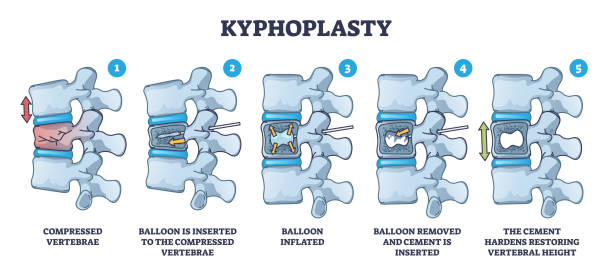What is a Kyphoplasty
Kyphoplasty are ways of treating vertebral body compression fractures, which are small breaks in the thick mass of bone that makes up the front part of your spinal column (the vertebral body). Vertebral body fractures lead to the collapse or compression of a vertebra, causing your spine to shorten and curve forward. This can result in pain and a kyphotic (hunched-over) deformity.
Thinning of bones, or osteoporosis, is the main cause of vertebral compression fractures. Pathologic fractures related to spinal tumors may also be a cause.
Who is a candidate for kyphoplasty procedures? What kinds of conditions are treated?
Kyphoplasty are generally reserved for people with painful progressive (increasing) back pain caused by osteoporotic or pathologic vertebral compression fractures. Candidates for these procedures often have a reduced ability to move and function because of the fractures.
To be a candidate for a kyphoplasty, your pain must be related to the vertebral fracture, and must not be due to other problems, such as disk herniation, arthritis, or stenosis (narrowing). Imaging tests — such as spinal x-rays, bone scans and computed tomography (CT) or magnetic resonance imaging (MRI) scans — might be ordered to confirm the presence of a vertebral fracture. If you have osteoporosis, your healthcare provider may order a dual energy x-ray absorptiometry (DXA) scan.
What type of anesthesia is used during a kyphoplasty procedure?
Kyphoplasty are considered minimally invasive procedures that are most often performed using general or local anesthesia, depending on the healthcare provider and your needs.
What are the benefits of kyphoplasty?
After the bone cement is inserted into the vertebra, 75% of patients are active again. You might be symptom free and you won’t have to do physical therapy or rehabilitation.
About Authors
Dr. Muhammad Mahmood Ahmad is a Spinal as well as an Orthopedic Surgeon with over 14 years of experience currently practicing at Razia Saeed Hospital, Multan.






